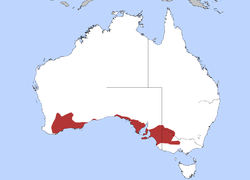Description
The purple-gaped honeyeater is a medium-sized (16-19 centimetres) honeyeater which is generally grey-olive above and buffish yellow below. [3] They have a patterned head, with a black eyestripe against a grey background and purple gape above a yellow streak on the throat and pointed yellow ear coverts. [3] Juveniles are similar, but with duller facial patterns, slightly browner plumage, and a yellow gape and gape line. [2] The Kangaroo Island subspecies is considered to be larger and darker than the mainland subspecies. [2]
Similar species include yellow-plumed honeyeater and singing honeyeater. [4] The bird is also named Wattle-Cheeked Honeyeater in Birds of Australia vol 11 by Gregory Mathews [5]
Call
The song is a clear toweet-toweet-toweet, followed by a high-pitched yep-yep-yep, often performed from a tall branch, including before dawn. [2] [4]
Ecology and behaviour
The main habitat type for purple-gaped honeyeater is mallee woodland and shrubland. [4] This includes bull mallee, with patches of green mallee or blue mallee. [4] They also occur in yellow gum woodland with dense thickets of 'totem-poles' or violet honey-myrtle on low-lying flats and gullies in mallee areas. [4] They are occasionally recorded in river red gums bordering waterways, [3] and seasonally in red ironbark woodlands when they are in flower. [4] Purple-gaped honeyeaters can also occasionally be found in gardens. [2]
They are gregarious, usually seen in pairs, or groups of 3-8 birds. [4] Generally considered quiet and unobtrusive, except in spring when they may call often. [4] They are known to regularly drink and bathe, particularly in warmer weather. [4] Purple-gaped honeyeaters associate with yellow-plumed honeyeater and tawny-crowned honeyeater, [4] but can be aggressive towards other honeyeaters, [2] and frequently chase other birds, particularly when feeding. [3]
Diet
Purple-gaped honeyeaters feed mainly on nectar and insects, [2] especially from flowering mallee eucalypts, [4] and banksias. [3] They also forage for insects under loose bark on trunks and branches of trees, or catch flying insects on the wing. [4] [3] Seeds, pollen and honeydew from scale insects are less frequently consumed. [3]
Reproduction
Purple-gaped honeyeaters build nests as a small cup of bark strips, grass and down, bound with spider web and egg sacs, slung in a horizontal fork or from slender branchlets within dense foliage (usually broombush or eucalypts), normally less than three metres above the ground. [3]
This page is based on this
Wikipedia article Text is available under the
CC BY-SA 4.0 license; additional terms may apply.
Images, videos and audio are available under their respective licenses.


